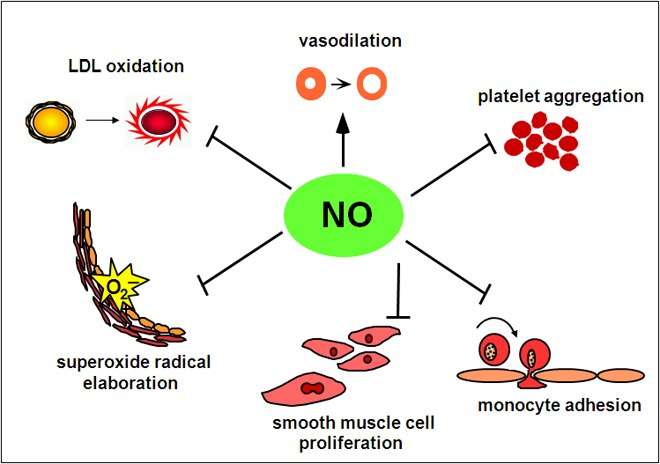Scientists determine how gaseous substances in the human body affect psyche and behavior

Professor Alexander Oleskin from the Lomonosov Moscow State University and colleagues have published a study in Microbial Ecology in Health and Disease devoted to the review of gaseous neurotransmitters of microbial origin and their role in the human body.
"Our brain cannot work without neurotransmitters—substances that transmit impulses from one nerve cell to another. Some neurotransmitters are gaseous substances, gasotransmitters. Our brain uses gases such as hydrogen sulfide, ammonia, and even carbon monoxide to transfer information between cells," Alexander Oleskin says. "Bacteria that inhabit the body, and especially the intestine, also create gasotransmitters that affect our brain, mind and behavior."
Gasotransmitters are produced in various organs and tissues. The name "gasotransmitters" is related to the term "neurotransmitters." These are substances that serve for the transmission of impulses between nerve cells, including the brain, where such gas transmitters as NO, CO and H2S are generated by means of special enzymes.
The review article provides an extensive analysis of the data related to the mechanisms of action of gaseous substances of microbial origin. Among them are nitric oxide (NO), carbon monoxide (CO), hydrogen sulfide (H2S), methane (CH4), hydrogen (H2) and ammonia (NH3). They are believed to be regulators of human behavior and neurophysiological and mental disorders. These gases are among the smallest biologically active molecules that perform vital functions in both multi-cellular organisms and bacteria.They act as mediators and regulators in intercellular interactions in the bodies of mammals.
Importantly, substances that act as gasotransmitters are synthesized in the gastrointestinal tract both by the cells of the host organism and a variety of gastrointestinal microorganisms that inhabit it, including Archaea, Bacteroides, Bifidobacterium, Butyrivibrio, Clostridium, Collinsella, Coprococcus, Desulfovibrio, Eubacterium, Lactobacillus, Prevotella, Propionibacterium, Roseburia, and others.
The gastrointestinal (GI) tract of an adult contains about 20 ml of gaseous products, producing from 400 to 1200 ml per day. Nitrogen, oxygen, hydrogen, methane, carbon dioxide and hydrogen sulfide constitute 20 to 90 percent, 3.9 to 10 percent, 20.9 to 50 percent, 7.2 to 10 percent, 9 to 30 percent and 0.00028 percent respectively of the total volume. Their numbers vary depending on diet. The gaseous products are formed as the result of various eukaryotic (human) and prokaryotic (bacterial) cells' activity by enzymatic or non-enzymatic processes. The majority of the gas is removed from the intestines, absorbed and transferred to the bloodstream, and eventually removed from the body through the respiratory system.
Gasotransmitters play a dual role in the body. They may serve as energy sources for the inhabiting microbes. For instance, the intestinal bacterium Escherichia coli (E. coli), which lives in the digestive tract, uses nitric oxide (NO) generated by the host cells as an energy source for its metabolism. As nitric oxide is also produced actively by the immune cells during inflammation, it turns out that E. coli has a particular interest in the development of inflammation in the intestines.
Gasotransmitters are involved both in the communication between microbial cells and the "dialogue" between the microbial "life partners" and the host cells. The nitric oxide (NO) produced by the host organism or its microbes regulates the functioning of the immune and cardiovascular systems and acts as a brain neurotransmitter involved in the regulation of learning and cognitive activities. Under experimental conditions, mice deficient in one of the nitric oxide-forming enzymes (neuronal NO-synthase) exhibit increased motor and sexual activity and long-term depression.
Hydrogen sulphide (H2S) at low concentrations regulates a number of processes in human organs, especially the cardiovascular and nervous systems. Hydrogen sulfide acts as a neuroprotector. The effect of insufficient concentration in the nervous system was demonstrated in studies with patients with epileptic seizures, psychiatric disorders, or pathological changes in the electroencephalogram. Many of these patients are deficient in enzymes that produce hydrogen sulfide in the body. Patients with Down syndrome, by contrast, have increased activity of the enzymes that form hydrogen sulfide.
An excess of ammonia (NH3) in the body (hyperammonemia), may be due to disorders in the gastrointestinal microbiota (dysbiosis). It results in accumulation of significant concentrations of NH3 in the brain. This situation is characteristic of liver cirrhosis and poses the threat of hepatic encephalopathy.
Gasotransmitters affect the cells that formed them (autocrine action), adjacent cells (paracrine action), and distant tissues and organs and the whole body systemically (endocrine action). The production of the gas transmitters and the distribution to various areas of the body depends on the activity of body cells and the microbial symbionts. The concentrations and activities of gas transmitters are under a combined influence of the brain and the entire nervous system (including intestinal nerve cells that constitute the enteric nervous system), the immune system.They are also influenced by the gastrointestinal microbiota and that of other body areas (the skin, the respiratory tract, the uro-genital tract etc.).
"Prospectively, the research findings will be implemented in medical and psychiatric practice. They will serve for the treatment and prevention of neuropsychiatric disorders, including depression, increased aggressiveness, and others, using microbial gas transmitters. It seems feasible, for instance, to attempt to normalize the amount of ammonia with the help of bacteria that will be introduced into the body in a goal-directed fashion'" hypothesizes Alexander Oleskin.
There are some developments in this direction based on useful microorganisms, i.e., probiotics that can be consumed with milk products (yoghurt, cheese etc.), or in pharmaceutical formulations. They help by administering potentially poisonous gases in minute amounts to improve human health and normalize behavior. Probiotic strains of lactobacilli, bifidobacteria, and E. coli actively synthesize one of the most important multifunctional gas transmitters, nitric oxide; moreover, probiotics additionally stimulate nitric oxide production by the cells of the host organism.
The term "psychobiotics" has recently been introduced to designate the probiotic bacterial strains that are used as dietary supplements to optimize functioning of the brain and whole-body activities by making use of the beneficial effects of microbial products, including gas transmitters, on the brain and behavior.

















